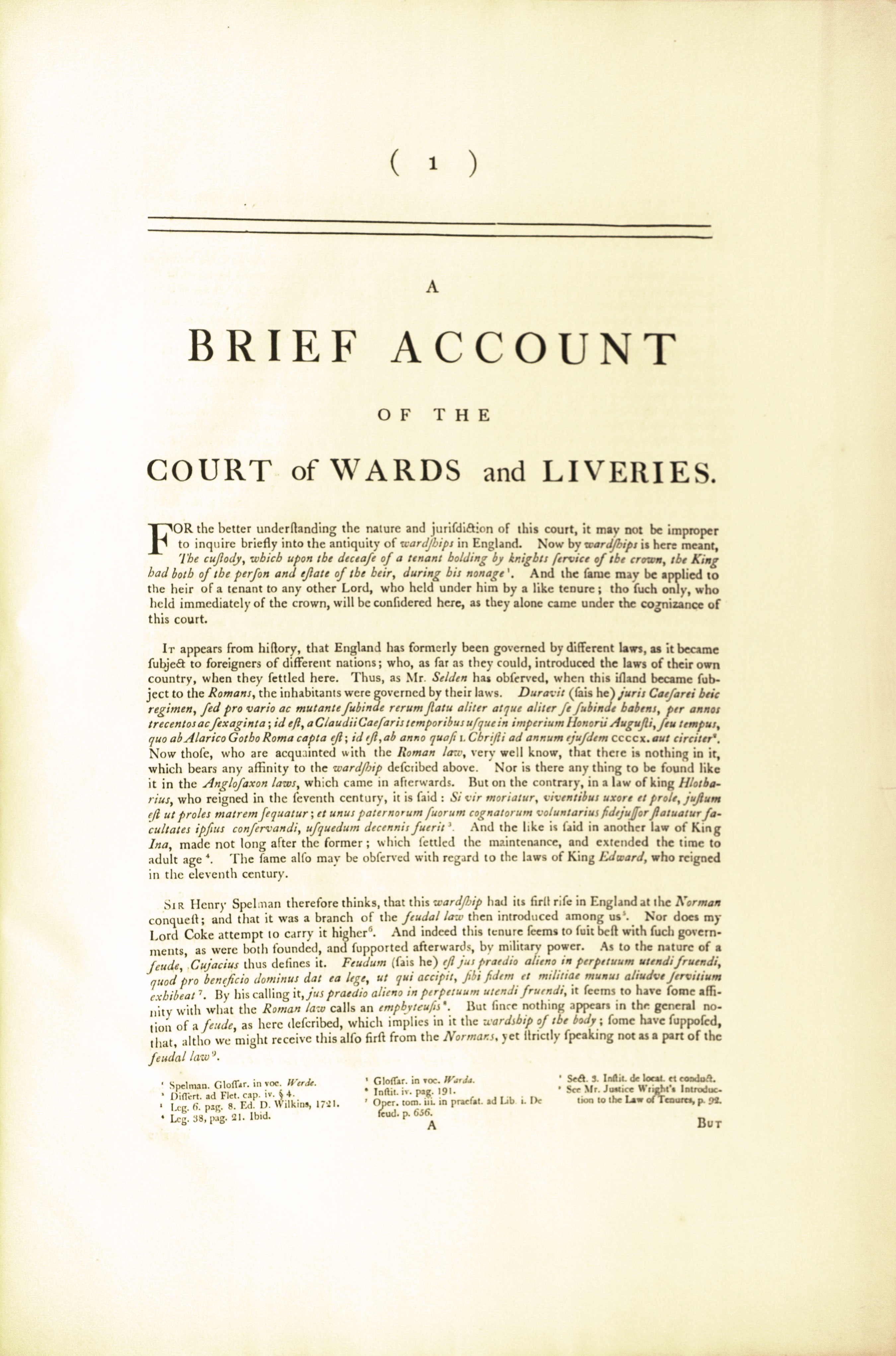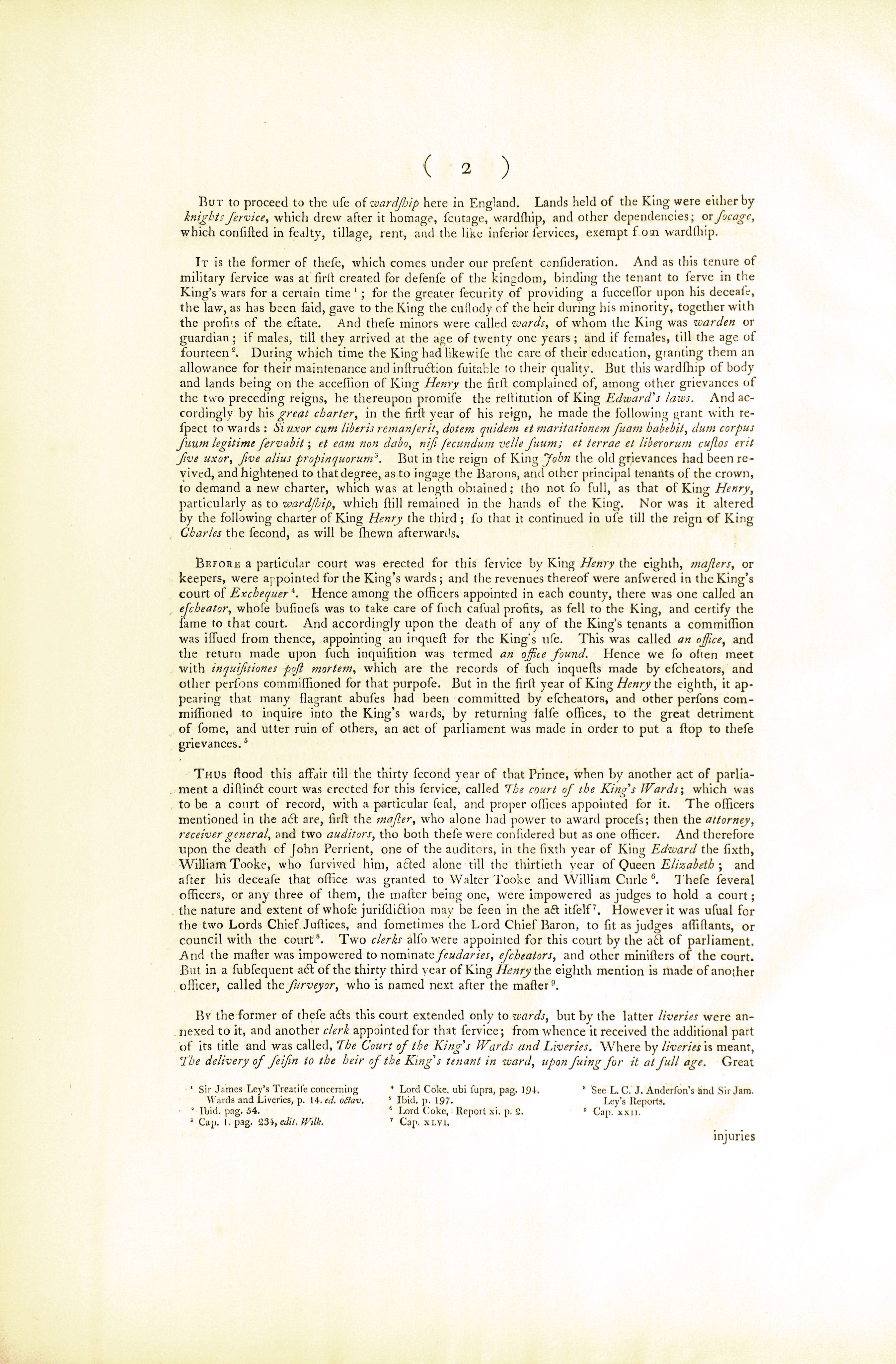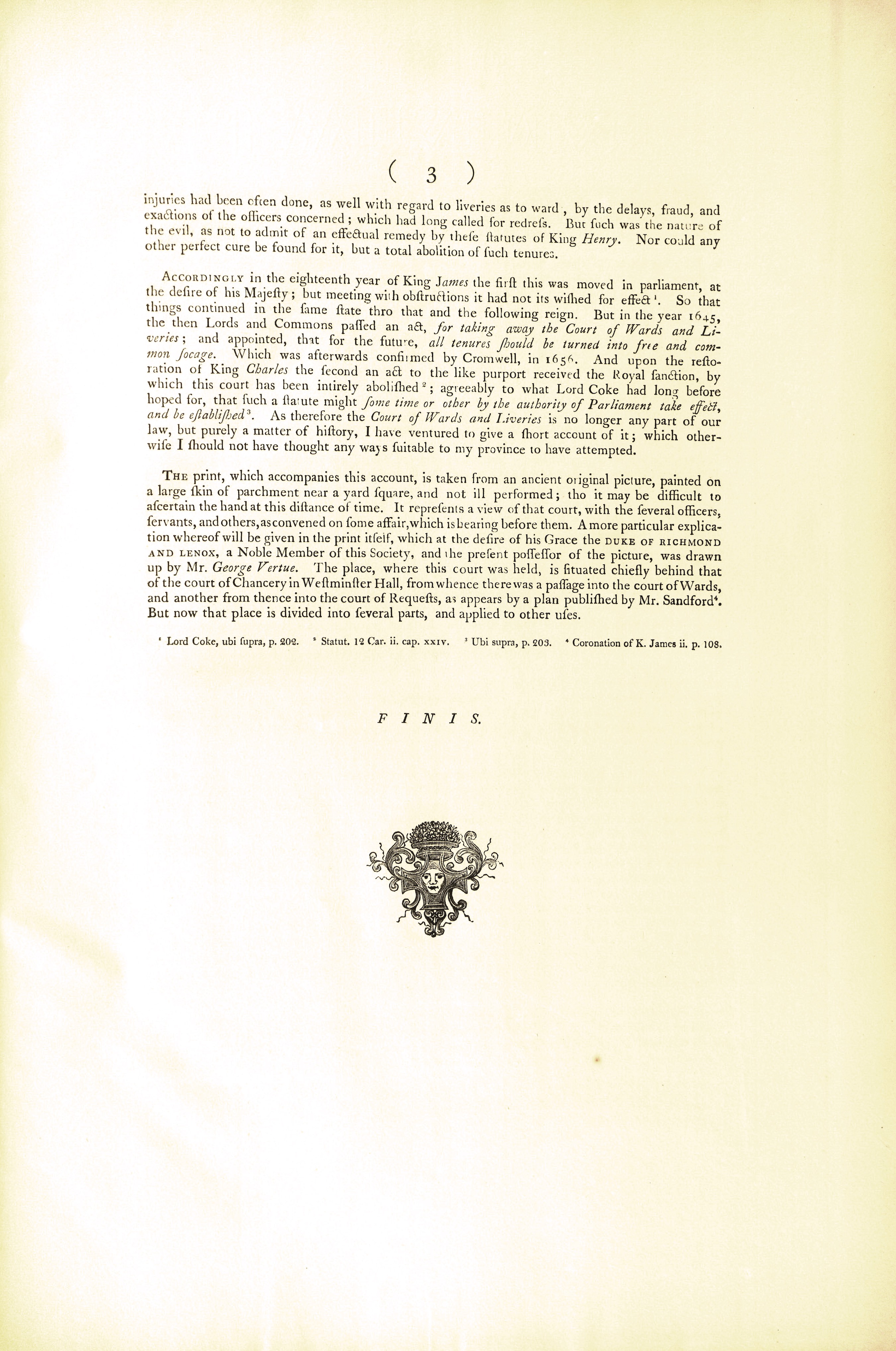
Creative Commons Attribution-Noncommercial-No Derivative Works 3.0
Plate 1.70: The Court of Wards and Liveries (Original Explanatory Account)
1 media/vm1-02-cropped.jpg 2019-06-12T08:20:28+00:00 Crystal B. Lake b7829cc6981c2837dafd356811d9393ab4d81adc 31 32 Original Explanatory Account for Vetusta Monumenta, Plate 1.70. Written by John Ward. plain 2024-01-18T19:48:16+00:00 Noah Heringman ed5eca6418903b1281787a0c30645d943ca84184
[ (Page) 1 ]
A BRIEF ACCOUNT OF THE COURT of WARDS and LIVERIES.
FOR the better understanding the nature and jurisdiction of this court, it may not be improper to inquire briefly into the antiquity of wardships in England. Now by wardships is here meant, The custody, which upon the decease of a tenant holding by knights service of the crown, the King had both of the person and estate of the heir, during his nonage1.
Read more/less...And the same may be applied to the heir of a tenant to any other Lord, who held under him by a like tenure; tho such only, who held immediately of the crown, will be considered here, as they alone came under the cognizance of this court.
IT appears from history, that England has formerly been governed by different laws, as it became subject to foreigners of different nations; who, as far as they could, introduced the laws of their own country, when they settled here. Thus, as Mr. Selden has observed, when this island became subject to the Romans, the inhabitants were governed by their laws. Duravit (sais he) juris Caesarei heic regimen, sed pro vario ac mutante subinde rerum statu aliter atque aliter se subinde habens, per annos trecentos ac sexaginta; id est, a Claudii Caesaris temporibus usquein imperium Honorii Augusti, seu tempus, quo ab Alarico Gotho Roma capta est; id est, ab anno quasi I. Christi ad annum ejusdem CCCCX. aut circiter2. [The rule of Caesar’s law (he says) lasted here, though taking now one form, now another in response to frequently varied and changing circumstances, for three hundred and sixty years; that is, from the times of Claudius Caesar until the reign of Honorius Augustus or the time when Rome was captured by Alaric the Goth; that is, from almost the year of J. Christ to the year 410 of the same or thereabouts.] Now those, who are acquainted with the Roman law, very well know, that there is nothing in it, which bears any affinity to the wardship described above. Nor is there anything to be found like it in the Anglosaxon laws, which came in afterwards. But on the contrary, in a law of king Hlotharius, who reigned in the seventh century, it is said: Si vir moriatur, viventibus uxore et prole, justum est ut proles matrem sequatur; et unus paternorum suorum cognatorum voluntarius fidejussor statuatur facultates ipsius conservandi, usquedum decennis fuerit3. [If a husband dies while his wife and child are alive, it is right that the child follow the mother; and one of his paternal relatives be appointed voluntary conservator of his estate until he is ten years old.] And the like is said in another law of King Ina, made not long after the former; which settled the maintenance, and extended the time to adult age4. The same also may be observed with regard to the laws of King Edward, who reigned in the eleventh century.
SIR Henry Spelman therefore thinks, that this wardship had its first rise in England at the Norman conquest; and that it was a branch of the feudal law then introduced among us5. Nor does my Lord Coke attempt to carry it higher6. And indeed this tenure seems to suit best with such governments, as were both founded, and supported afterwards, by military power. As to the nature of a feude, Cujacius thus defines it. Feudum (sais he) est jus praedio alieno in perpetuum utendi fruendi, quod pro beneficio dominus dat ea lege, ut qui accipit, sibi fidem et militiae munus aliudve servitium exhibeat7. [A fief (says he) is the right to use and enjoy another’s estate in perpetuity, which a lord grants as a benefice on the condition that he who accepts it tender him loyalty and military service or another service.] By his calling it, jus praedio alieno in perpetuum utendi fruendi, it seems to have some affinity with what the Roman law calls an emphyteusis8. But since nothing appears in the general notion of a feude, as here described, which implies in it the wardship of the body; some have supposed, that, altho we might receive this also first from the Normans, yet strictly speaking not as a part of the feudal law9.
1Spelman. Glossar. in voc. Werde.
2Dissert. ad Flet. cap. iv. §4.
3Leg. 6. pag. 8. Ed. D. Wilkins, 1721.
4Leg. 38, pag. 21. Ibid.
5Glossar. in voc. Warda.
6Instit. iv. pag. 191.
7Oper. tom. iii. in praesat. ad Lib. i. De feud. p. 656.
8Sect. 3. Instit. de locat. et conduct.
9See Mr. Justice Wright’s Introduction to the Law of Tenures, p. 92.

[ (Page) 2 ]
BUT to proceed to the use of wardship here in England. Lands held of the King were either by knights service, which drew after it homage, scutage, wardship, and other dependencies; or socage, which consisted in fealty, tillage, rent, and the like inferior services, exempt from wardship.
Read more/less...IT is the former of these, which comes under our present consideration. And as this tenure of military service was at first created for defense of the kingdom, binding the tenant to serve in the King’s wars for a certain time1; for the greater security of providing a successor upon his decease, the law, as has been said, gave to the King the custody of the heir during his minority, together with the profits of the estate. And these minors were called wards, of whom the King was warden or guardian; if males, till they arrived at the age of twenty one years; and if females, till the age of fourteen2. During which time the King had likewise the care of their education, granting them an allowance for the maintenance and instruction suitable to their quality. But this wardship of body and lands being on the accession of King Henry first complained of, among other grievances of the two proceeding reigns, he thereupon promised the restitution of King Edward's laws. And accordingly by his great charter, in the first year of his reign, he made the following grant with respect to wards: Si uxor cum liberis remanserit, dotem quidem et maritationem suam habebit, dum corpus suum legitime servabit; et eam non dabo, nisi secundum velle suum; et terrae et liberorum custos erit sive uxor, sive alius propinquorum3. [If a wife remains with her children, she shall keep her dowry and married status so long as she lawfully preserves her body; and I will not give her [to another to marry] except according to her will; and the guardian of her land and children shall be either the wife or one of her relatives.] But in the reign of King John the old grievances had been revived, and heightened to that degree, as to ingage the Barons, and other principal tenants of the crown, to demand a new charter, which was at length obtained; tho not so full, as that of King Henry, particularly as to wardship, which still remained in the hands of the King. Nor was it altered by the following charter of King Henry the third; so that it continued in use till the reign King Charles the second, as will be shewn afterwards.
BEFORE A particular court was erected for the service by King Henry the eighth, masters, or keepers, were appointed for the King’s wards; and the revenues thereof were answered in the King’s court of Exchequer4. Hence among the officers appointed in each county, there was one called an escheator, whose business was to take care of such casual profits, as fell to the King, and certify the same to that court. And accordingly upon the death of any of the King’s tenants a commission was issued from thence, appointing an inquest for the King’s use. This was called an office, and the return made upon such inquisition was termed an office found. Hence we so often meet with inquisitiones post mortem, which are the records of such inquests made by escheators, and other persons commissioned for that purpose. But in the first year of King Henry the eighth, it appearing that many flagrant abuses had been committed by escheators, and other persons commissioned to inquire into the King’s wards, by returning false offices, to the great detriment of some, and utter ruin of others, an act of parliament was made in order to put a stop to these grievances5.
THUS stood this affair till the thirty second year of that Prince, when by another act of parliament a distinct court was erected for this service, called The court of the King’s Wards; which was to be a court of record, with a particular seal, and proper offices appointed for it. The officers mentioned in the act are, first the master, who alone had the power to award process; then the attorney, receiver general, and two auditors, tho both these were considered but as one officer. And therefore upon the death of John Perrient, one of the auditors, in the sixth year of King Edward the sixth, William Tooke, who survived him, acted alone till the thirtieth year of Queen Elizabeth; and after his decease that office was granted to Walter Tooke and William Curle6. These several officers, or any three of them, the master being one, were impowered as judges to hold a court; the nature and extent of whose jurisdiction may be seen in the act itself7. However it was usual for the two Lords Chief Justices, and sometimes the Lord Chief Baron, to sit as judges assistants, or council with the court8. Two clerks also were appointed for this court by the act of parliament. And the master was impowered to nominate feudaries, escheators, and other ministers of the court. But in a subsequent act of the thirty third year of King Henry the eighth mention is made of another officer, called the surveyor, who is named next after the master9.
BY the former of these acts the court extended only to wards, but by the latter liveries were annexed to it, and another clerk appointed for that service; from whence it received the additional part of its title and was called, The Court of the King’s Wards and Liveries. Where by liveries is meant, the delivery of seisin to the heir of the King’s tenant in ward, upon suing for it at full age. Great
1Sir James Ley’s Treatise concerning Wards and Liveries, p. 14. ed. octav.
2Ibid. pag. 54.
3Cap. 1. pag. 234, edit. Wilk.
4Lord Coke, ubi supra, pag. 194.
5Ibid. p. 197.
6Lord Coke, Report xi. p. 2.
7Cap. XLVI.
8See L. C. J. Anderson’s and Sir Jam. Ley’s Reports.
9Cap. XXII.

[ (Page) 3 ]
injuries had been often done, as well with regard to liveries as to wards, by the delays, fraud, and exactions of the officers concerned; which had long called for redress. But such was the nature of the evil, as not to admit of an effectual remedy by these statutes of King Henry. Nor could any other perfect cure be found for it, but a total abolition of such tenures.
Read more/less...ACCORDINGLY in the eighteenth year of King James the first this was moved in parliament, at the desire of his Majesty; but meeting with obstructions it had not its wished for effect1. So that things continued in the same state thro that and the following reign. But in the year 1645, the then Lords and Commons passed an act, for taking away the Court of Wards and Liveries; and appointed, that for the future, all tenures should be turned into free and common socage. Which was afterwards confirmed by Cromwell, in 1656. And upon the restoration of King Charles the second an act to the like purport received the Royal sanction, by which the court has been intirely abolished2; agreeably to what Lord Coke had long before hoped for, that such a statute might some time or other by the authority of Parliament take effect, and be established3. As therefore the Court of Wards and Liveries is no longer any part of our law, but purely a matter of history, I have ventured to give a short account of it; which otherwise I should not have thought any ways suitable to my province to have attempted.
THE print, which accompanies this account, is taken from an ancient original picture, painted on a large skin of parchment near a yard square, and not ill performed; tho it may be difficult to ascertain the hand at this distance of time. It represents a view of that court, with the several officers, servants, and others, as convened on some affair, which is bearing before them. A more particular explication whereof will be given in the print itself, which at the desire of his Grace the DUKE OF RICHMOND AND LENOX, a Noble Member of this Society, and the present possessor of the picture, was drawn up by Mr. George Vertue. The place, where this court was held, is situated chiefly behind that of the court of Chancery in Westminster Hall, from whence there was a passage into the court of Wards, and another from thence into the court of Requests, as appears by a plan published by Mr. Sandford4. But now that place is divided into several parts, and applied to other uses.
1Lord Coke, ubi supra, p. 202.
2Statut. 12 Car. ii. cap. XXIV.
3Ubi supra, p. 203.
4Coronation of K. James ii. p. 108.
FINIS.